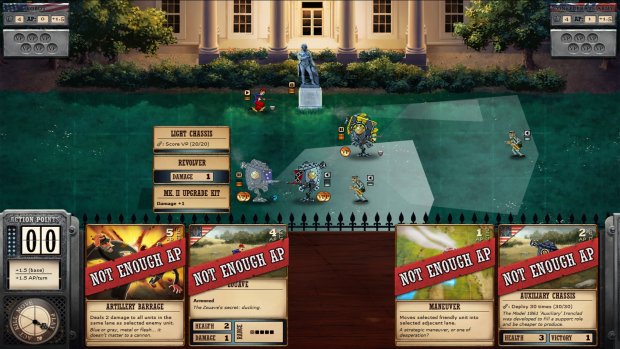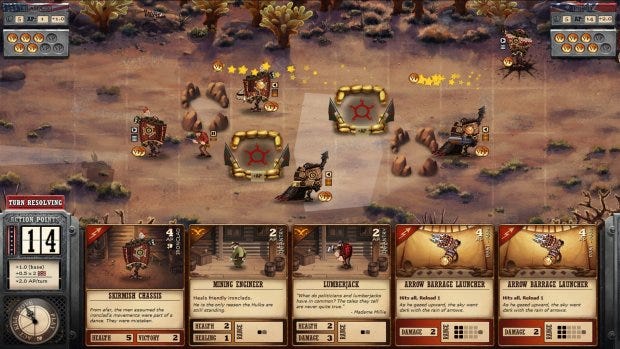Wot I Think: Ironclad Tactics
Skirmish and Nemesis
The American Civil War was a pretty big deal over there, I hear, and Ironclad Tactics poses a profound question about it. What if, instead of all that boring nonsense about bondage and confederacies, it was really all about robots? And what if, for example, the Native Americans had robots too with tomahawks and ting? Wouldn't that be pretty awesome?
The answer is that yes, yes it would.
Ironclad Tactics is a card game which doesn't really play like a card game. This is more reminiscent of Plants Vs Zombies, with two armies battling across five lanes to get their Ironclads to the other side and score Victory Points. The Ironclads are of course robots, and make up the backbone of these beautifully-stylised factions – each one a little collection of Civil War miniatures, pootling and chugging along until, with a bloody splat, they collide.
Your units, tactics and parts take the form of cards, with your hand being replenished as each turn rolls over. There are six factions total and these further subdivide into Ironclads and infantry. The Ironclads are hulking radiation-powered robots that can squish infantry simply by walking over them, as well as equipping various guns and headpieces – and are also the only units that can earn Victory Points by reaching the opponent's end. There are tonnes of different Ironclads – armoured, cheap, fat, dancing, hidden – and a bevvy of loadout options, meaning you can end up with some pretty funny lineups. I'm a fan of a trumpet-playing armoured frontline, buffing up a fragile cannon-toting rear, perhaps even with a woodchipper up front to slow the enemy advance.

In the face of this it's pretty impressive that the infantry can, if used correctly, hold their own. They do less damage and can't be augmented in the same manner as Ironclads, but are also much cheaper and capable of capturing flags (which give you more Action Points to play cards) and traversing certain terrain that the robots can't. They're definitely support rather than the meat of the army, and will get crushed in straight-up fights, but have a tricksy side to them – like the Zouave, a rifleman that can duck incoming fire, or the Fox Runner, a scout that can suddenly whip out a rifle.
The campaign is sizeable and, after the first few levels, structured around unlocking cards by fulfilling different criteria – so one level might challenge you to squish at least four infantry with Ironclads, or protect a statue on the field, and so on. This gives the game an odd though not unpleasant rhythm whereby you kind of steam through two or three levels, then go over them again with custom decks to wring out all of the possible cards.

Some might have a problem with this, because you don't really have an option – to have a decent experience in multiplayer, you need to unlock cards. But Ironclad Tactics' decks are efficient beasts consisting of only two factions and twenty cards, so building a deck for each level isn't the big timesink it would be in other CCGs. The deck builder helps, too, with all the cards and filtering options presented clearly; once you've got the hang of things, it takes a couple of minutes at most to chuck together a specialised task force for any troublesome objectives.
The Ironclad Tactics campaign also has two subsidiary modes that are clever in theory but badly let down by their restrictions. Skirmish and Nemesis let you play most of the levels against another player, with one of you taking the role of the baddies and, in the case of Nemesis, using a specially-constructed boss deck. What a brilliant idea.

In practice these modes may as well not be in the game, because they're restricted to friends only – that is, you need someone on your Steam friends list who also has the game and has played through the campaign to the same point you have. I didn't, so I ended up adding random folk from forums in a desperate attempt to try out these modes and only succeeded in getting two games – it was a ballache, the kind of thing you shouldn't ever have to do.
The real problem is that you're not just missing out on these modes, but they actively hinder your progress in building a killer deck – every Skirmish and Nemesis challenge has unlockable cards associated with it, which obviously you can't get if you can't play. The few games I was able to get were fun because of the super-specific objective-based levels, but this badly needs patching to make use of the game's random 1vs1 matchmaking. At the very least it should let you play against a tough AI to have a chance at the card unlocks. As it is these modes are a real frustration.

As all of this suggests you can't play online, really, before finishing the Campaign. You just don't have the cards, and later cards walk all over their earlier equivalents. This isn't a huge problem, not least because the campaign's gimmicks do a good job of forcing you to throw together troubleshooter decks, so you'll have a good idea of potential playstyles. I favoured a mix of the Confederate and Native American factions, the former offering simple brute force and offensive variety while the latter have some of the best custom Ironclads in the game.
The Random 1vs1 matchmaking has a healthy playerbase, and the ongoing reward of a new faction's cards unlocking one-by-one as you stack up the wins. As Ironclad Tactics begins to reveal its depths the value of certain units shoots through the roof. I didn't use 'concealed' Ironclads, which can be deployed behind an existing Ironclad anywhere on the board, much in Campaign – but online, when you need one more VP, they're absolutely killer.
The time constraints on each turn, which don't feel too tight in Campaign, suddenly begin to throw all sorts of wrenches in the works and it's no exagerration to say entire matches often hinge on one bad move. One of the best aspects of Ironclad Tactics is how its system plays out in a turn-based manner, with defined periods for movement, actions, deaths etc – but the game never pauses. That is, you're able to queue moves to happen at just the right interval or, in the worst case scenario, get your timing wrong and screw moves up.

The best thing about Ironclad Tactics online is that it's surprising. I hadn't been using the jetpack Ironclads much, more fool me, until an online opponent turned up with a deckfull and promptly zoomed up to my poor troopers and squished 'em. Though the maps are assiduously symmetrical, there are also a variety of rules – so you can be playing straight-up, with the addition of flag areas to gain extra AP, or you might be in a blitz game that starts each player with 30AP and you only need 2 victory points to win.
The main problem with Ironclad Tactics multiplayer is one common in card games, from Magic all the way down. This is that, when one player gets in a leading position, they're far too often unassailable and the match has a lingering death. In Ironclad Tactics' case this is because you can basically camp out your opponent's spawning squares, and then slowly win over five or ten minutes of blowing away everything they send in while building up a ginormo-army behind your frontline.
It's basically asphyxiation, strategy-style, and I've both done it and had it done to me. There is an argument that if you end up in such a position you somehow deserve it due to bad play, but to my mind one bad move should not make for a slow death with little hope of escape. And as a player it puts you in an uncomfortable position. I've been in games where I knew for a fact I could win by being a dick, basically, and throttling off my opponent's entry squares – if you do it, you feel like a bad man, and if you don't then you're no longer playing competitively.
The fact that finely-poised matches can utterly tip one way with a bad move isn't the problem, so much as the match then taking ages to reach the foregone conclusion. But I don't want to overstate the issue because Ironclad Tactics otherwise seems quite balanced and this is a flaw across nearly every strategic card game.

One thing I will say in mitigation is that I had a longer list of issues with Ironclad Tactics; people leaving matches resulted in a draw, there were one or two cards that seemed ridiculous, and a few limbo-like matchmaking issues. And then, on Tuesday morning, a patch dropped that solved all of this – so developer Zachtronics is both paying attention and committed to fixing problems.
Ironclad Tactics is a streamlined take on deck-building that still manages to offer huge variety in its armies, and beyond all of that has great sound effects when you squish little dudes under hulking behemoths. I hate to finish off like the guy advertising cheezey peas, but this is one of those cases where, if you like CCGs and lane-based strategy games, you'll love Ironclad Tactics.

